Structural Behaviour and Mechanical Characteristics of BlueDeck Profiled Steel Sheeting for Use in Composite Flooring Systems
Abstract
:1. Introduction
2. Experimental Program
2.1. Materials
2.2. Specimen Design and Test Setup
2.2.1. Four-Point Bending Tests
2.2.2. Shear Tests
3. Test Results and Discussion
3.1. Four-Point Bending Tests
3.1.1. Load–Deflection Behaviour
3.1.2. Failure Modes
3.1.3. Relative Slip and De-Bonding Force
3.1.4. Flexural Stiffness
3.2. Shear Tests
4. Conclusions
Author Contributions
Funding
Data Availability Statement
Conflicts of Interest
References
- Lin, X.; Far, H.; Saleh, A. Structural Behaviour and Mechanical Properties of Welded Steel I-Girders with Corrugated Webs. Int. J. Steel Struct. 2019, 19, 1342–1352. [Google Scholar] [CrossRef]
- Chourasia, A.; Singhal, S.; Manivannan. Prefabricated volumetric modular construction: A review on current systems, chal-lenges, and future prospects. Pract. Period. Struct. Des. Constr. 2023, 28, 03122009. [Google Scholar] [CrossRef]
- Haydar, H.; Far, H.; Saleh, A. Portal steel trusses vs. portal steel frames for long-span industrial buildings. Steel Constr. 2018, 11, 205–217. [Google Scholar] [CrossRef]
- Far, H. Flexural Behavior of Cold-Formed Steel-Timber Composite Flooring Systems. J. Struct. Eng. 2020, 146, 06020003. [Google Scholar] [CrossRef]
- Tam, V.W.Y.; Tam, C.M.; Zeng, S.X.; Ng, W.C.Y. Towards adoption of prefabrication in construction. Build. Environ. 2007, 42, 3642–3654. [Google Scholar] [CrossRef]
- Khan, K.; Chen, Z.; Liu, J.; Javed, K. State-of-the-art on technological developments and adaptability of prefabricated industrial steel buildings. Appl. Sci. 2023, 13, 685. [Google Scholar] [CrossRef]
- Srisangeerthanan, S.; Hashemi, M.J.; Rajeev, P.; Gad, E.; Fernando, S. Review of performance requirements for inter-module connections in multi-story modular buildings. J. Build. Eng. 2020, 28, 101087. [Google Scholar] [CrossRef]
- Srisangeerthanan, S.; Hashemi, M.J.; Rajeev, P.; Gad, E.; Fernando, S. Development of an innovative boltless connection for multistory modular buildings. J. Struct. Eng. 2022, 148, 04022085. [Google Scholar] [CrossRef]
- Lawson, R.M.; Ogden, R.G.; Bergin, R. Application of modular construction in high-rise buildings. J. Archit. Eng. 2012, 18, 148–154. [Google Scholar] [CrossRef]
- AL Hunaity, S.A.; Far, H.; Saleh, A. Vibration behaviour of cold-formed steel and particleboard composite flooring systems. Steel Compos. Struct. 2022, 43, 403–417. [Google Scholar]
- Karki, D.; Al-Hunaity, S.; Far, H.; Saleh, A. Composite connections between CFS beams and plywood panels for flooring systems: Testing and analysis. Structures 2022, 40, 771–785. [Google Scholar] [CrossRef]
- Loss, C.; Frangi, A. Experimental investigation on in-plane stiffness and strength of innovative steel-timber hybrid floor diaphragms. Eng. Struct. 2017, 138, 229–244. [Google Scholar] [CrossRef]
- Pan, W.; Yang, Y.; Yang, L. High-rise modular building: Ten-year journey and future development. Constr. Res. Congr. 2018, 2018, 523–532. [Google Scholar]
- Lawson, R.; Ogden, R.; Pedreschi, R.; Grubb, P.; Ola, S.P. Developments in pre-fabricated systems in light steel and modular construction. Transport 2005, 35, 15. [Google Scholar]
- Fang, J.; Bao, W.; Ren, F.; Pang, L.; Jiang, J. Behaviour of composite beams with beam-to-girder end-plate connection under hogging moments. Eng. Struct. 2021, 235, 112030. [Google Scholar] [CrossRef]
- Guan, Y.; Wang, J.; Shi, Y.; Zhao, S.; Zhou, T.; Yao, X. Study on in-plane and out-of-plane bearing capacity of cold-formed steel composite floor with opening. J. Build. Eng. 2023, 70, 106246. [Google Scholar] [CrossRef]
- De Seixas, L.; Alberto, A.L.; De Miranda Batista, E. Experimental investigation of composite floor system with thin-walled steel trussed beams and partially prefabricated concrete slab. J. Constr. Steel Res. 2020, 172, 106172. [Google Scholar] [CrossRef]
- Dar, M.A.; Subramanian, N.; Dar, A.R.; Ghowsi, A.F.; Sidiqui, F.; Fayaz, S.; Mir, M.S. Comparison of various shear connectors for improved structural performance in CFS concrete composite slabs. Eng. Struct. 2020, 220, 111008. [Google Scholar] [CrossRef]
- Hassan, M.K.; Subramanian, K.B.; Saha, S.; Sheikh, M.N. Behaviour of prefabricated steel-concrete composite slabs with a novel interlocking system—Numerical analysis. Eng. Struct. 2021, 245, 112905. [Google Scholar] [CrossRef]
- Zhang, Z.; Tan, Y.; Shi, L.; Hou, L.; Zhang, G. Current state of using prefabricated construction in Australia. Buildings 2022, 12, 1355. [Google Scholar] [CrossRef]
- AS/NZS 2327; Composite Structures—Composite Steel-Concrete Construction in Buildings. SAI Global: Sydney, Australia, 2017.
- AS 1397; Continuous Hot-Dip Metallic Coated Steel Sheet and Strip—Coatings of Zinc and Zinc Alloyed with Aluminium and Magnesium. SAI Global: Sydney, Australia, 2011.
- AS 3600; Concrete Structures. SAI Global: Sydney, Australia, 2018.
- AS/NZS 1170.1; Structural Design Actions Permanent, Imposed and Other Actions. SAI Global: Sydney, Australia, 2002.
- ASTM D198-15; Standard Test Methods of Static Tests of Lumber in Structural Sizes. ASTM International: West Conshohocken, PA, USA, 2015.
- BS EN 26891; Timber Structures—Joints Made with Mechanical Fasteners—General Principles for the Determination of Strength and Deformation Characteristics. British Standards Institution (BSI): London, UK, 1991.
- BS EN 12512; Timber Structures—Test Methods—Cyclic Testing of Joints Made with Mechanical Fasteners. British Standards Institution (BSI): London, UK, 2001.
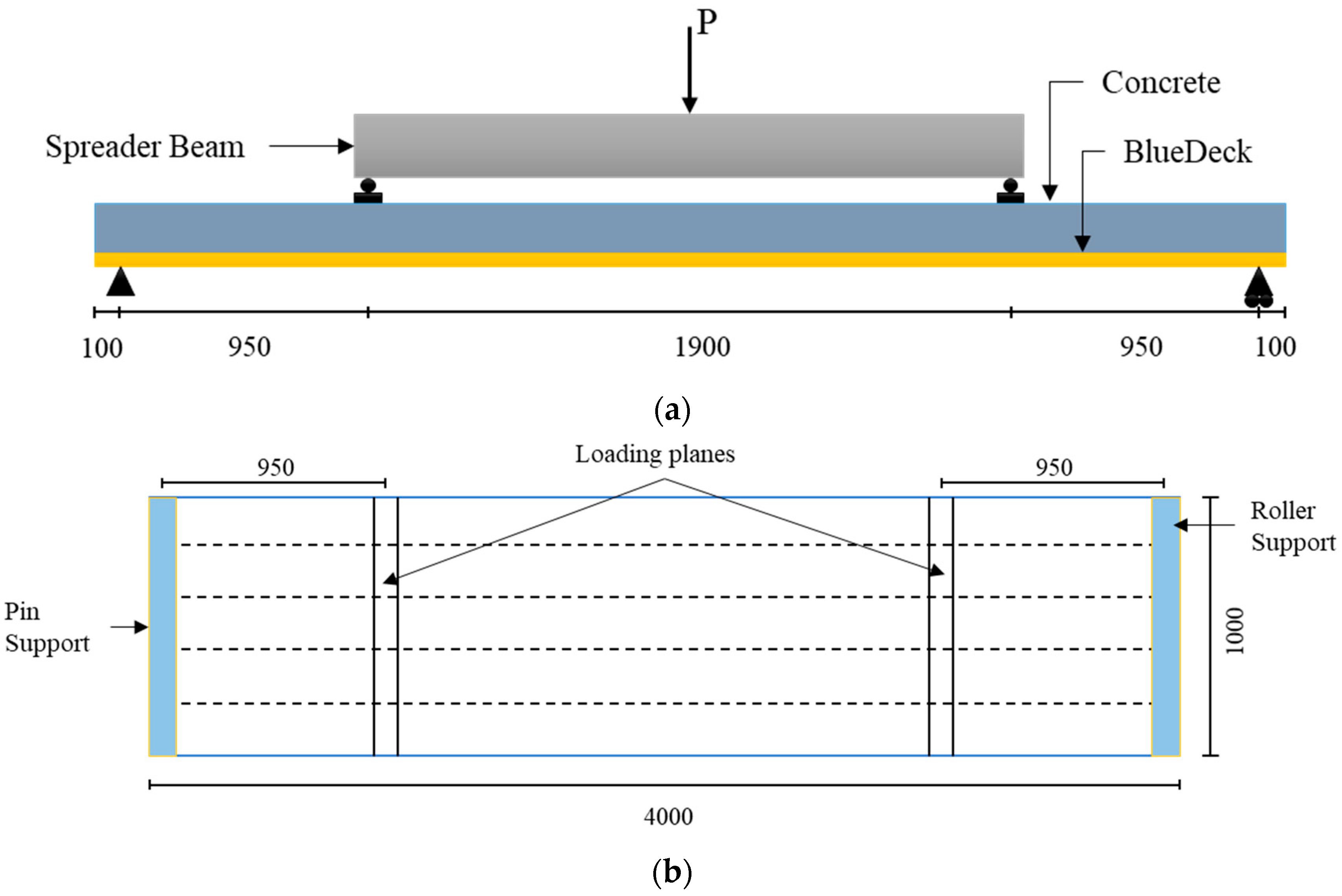

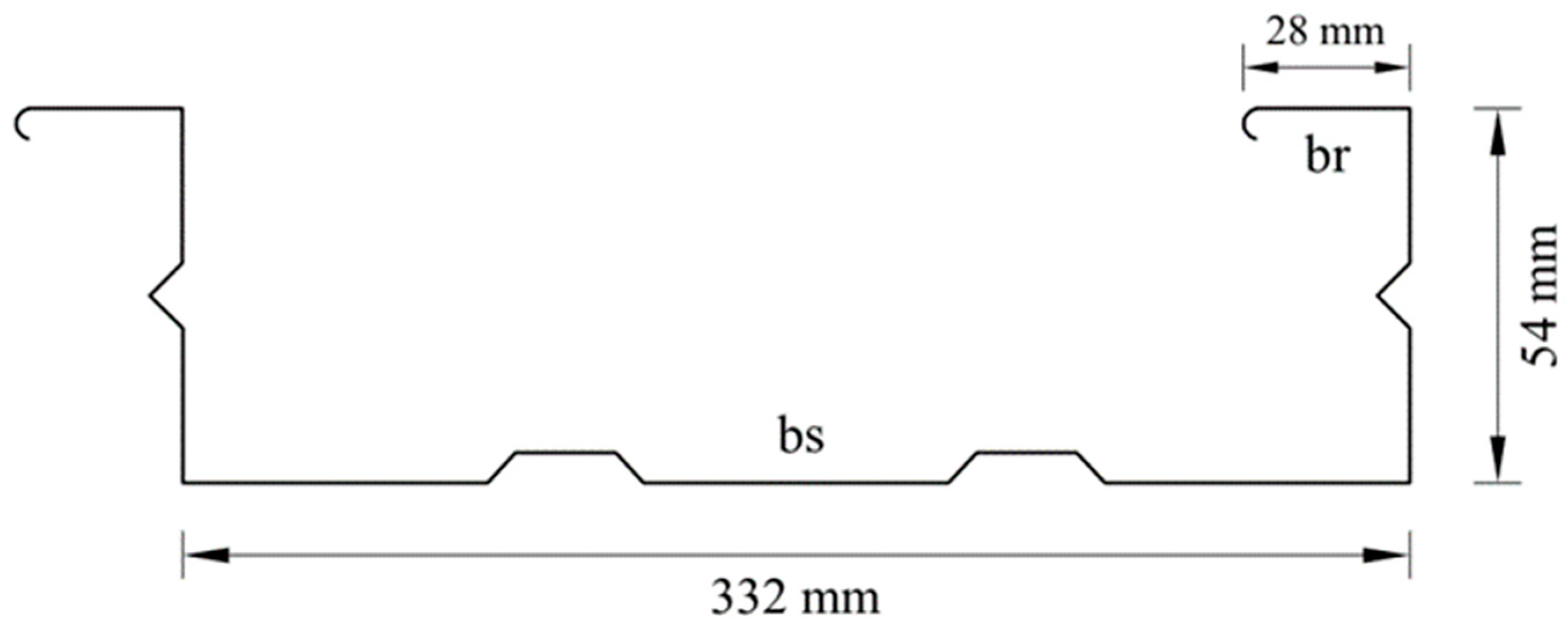

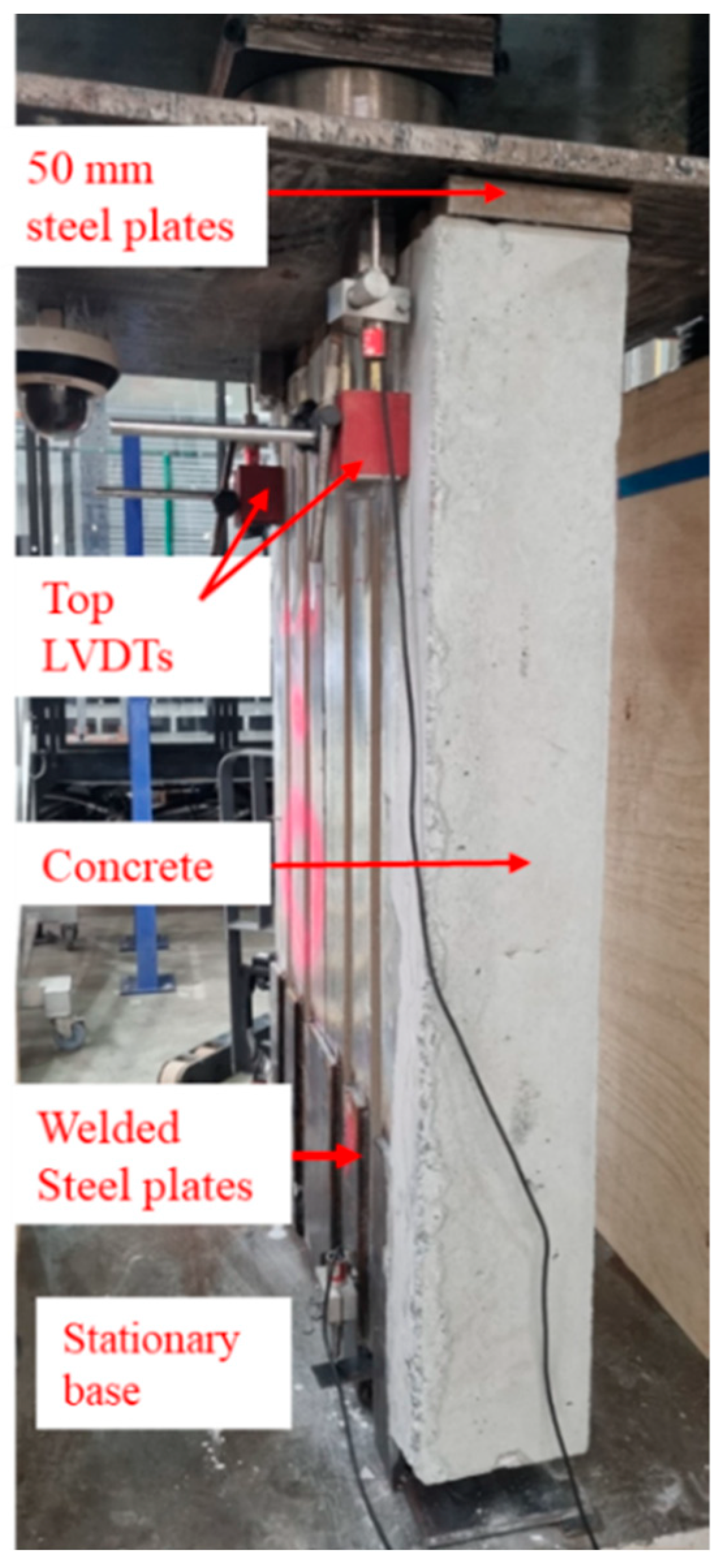
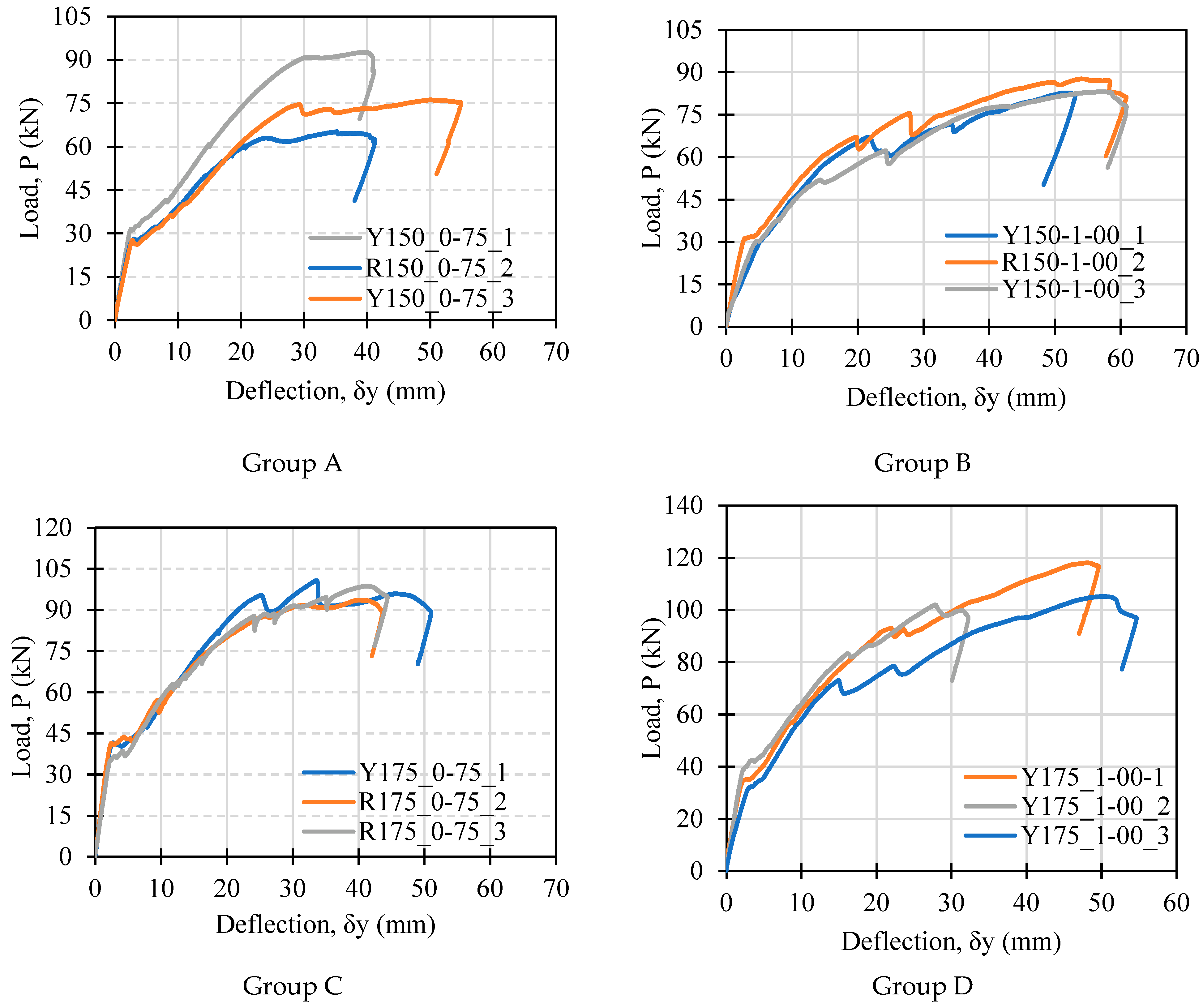

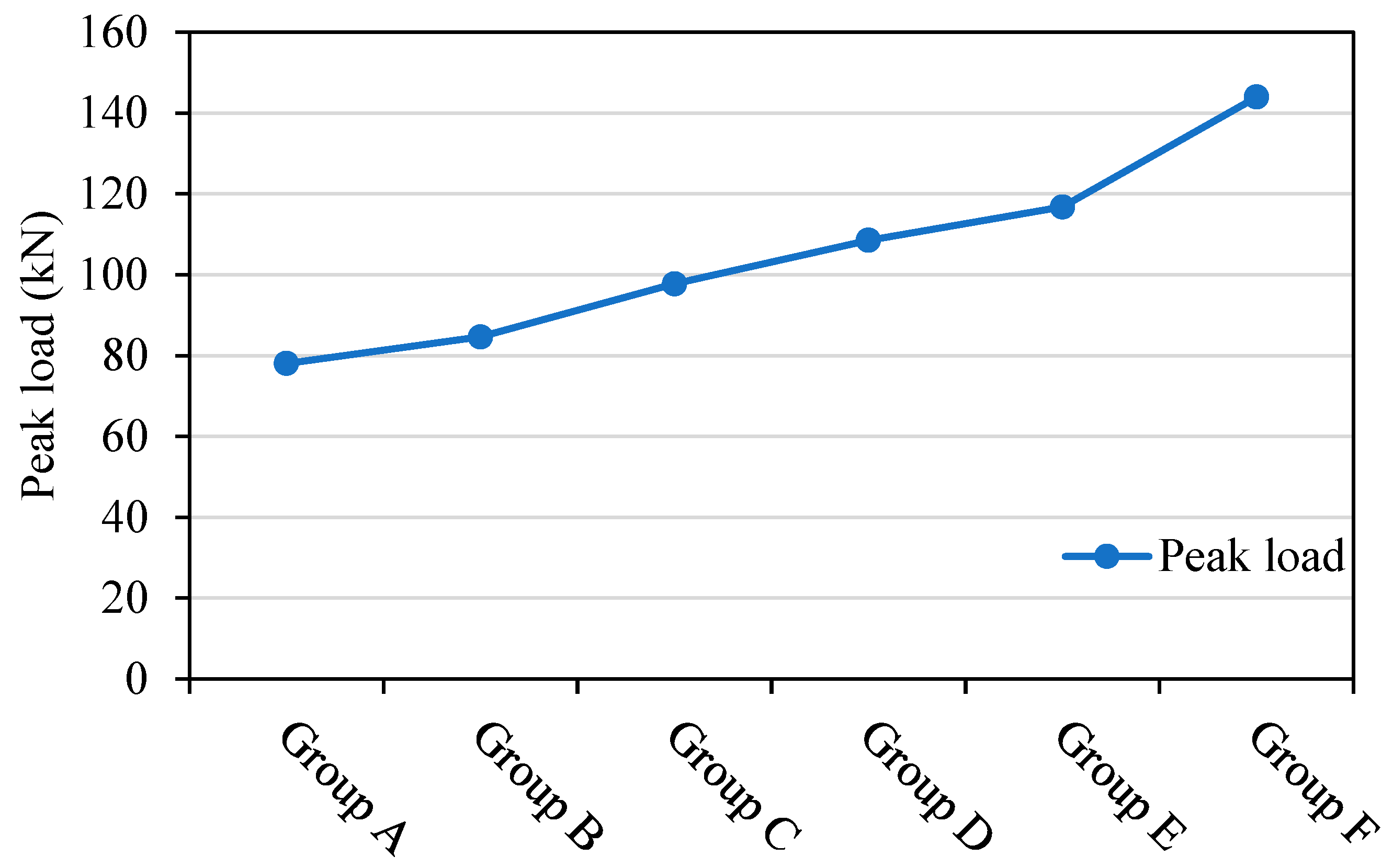
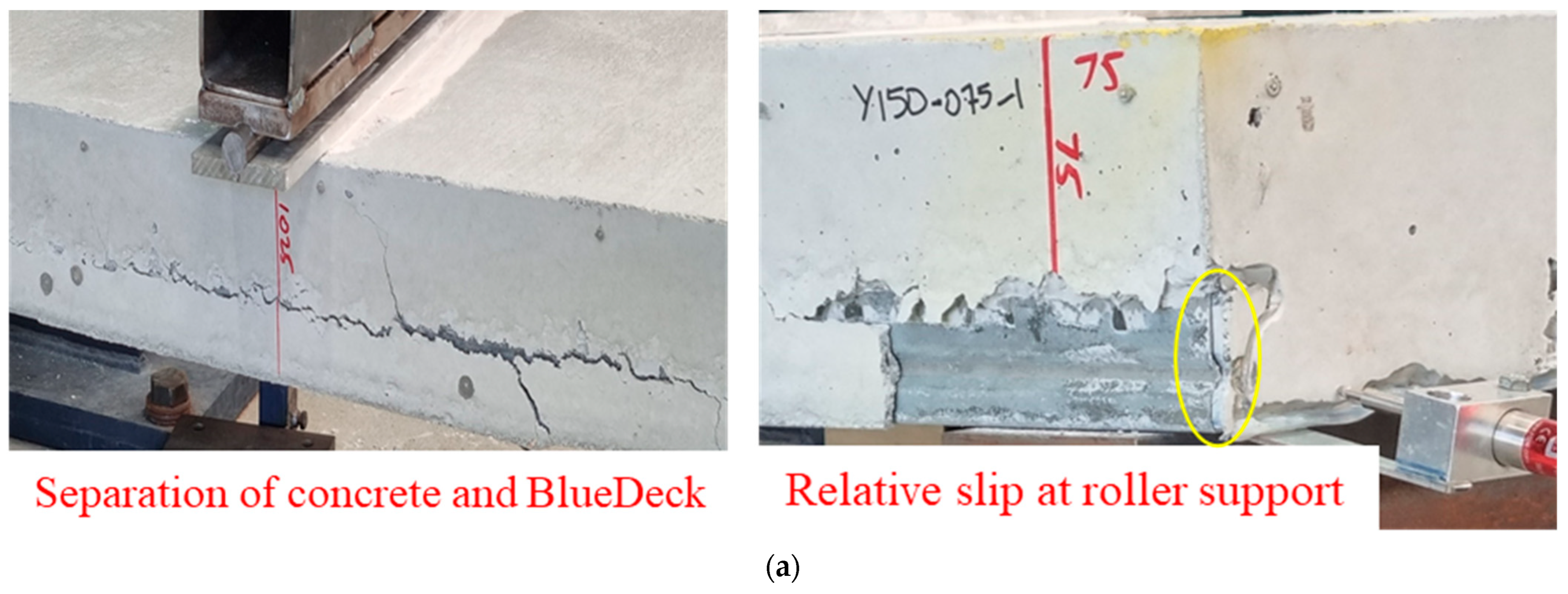
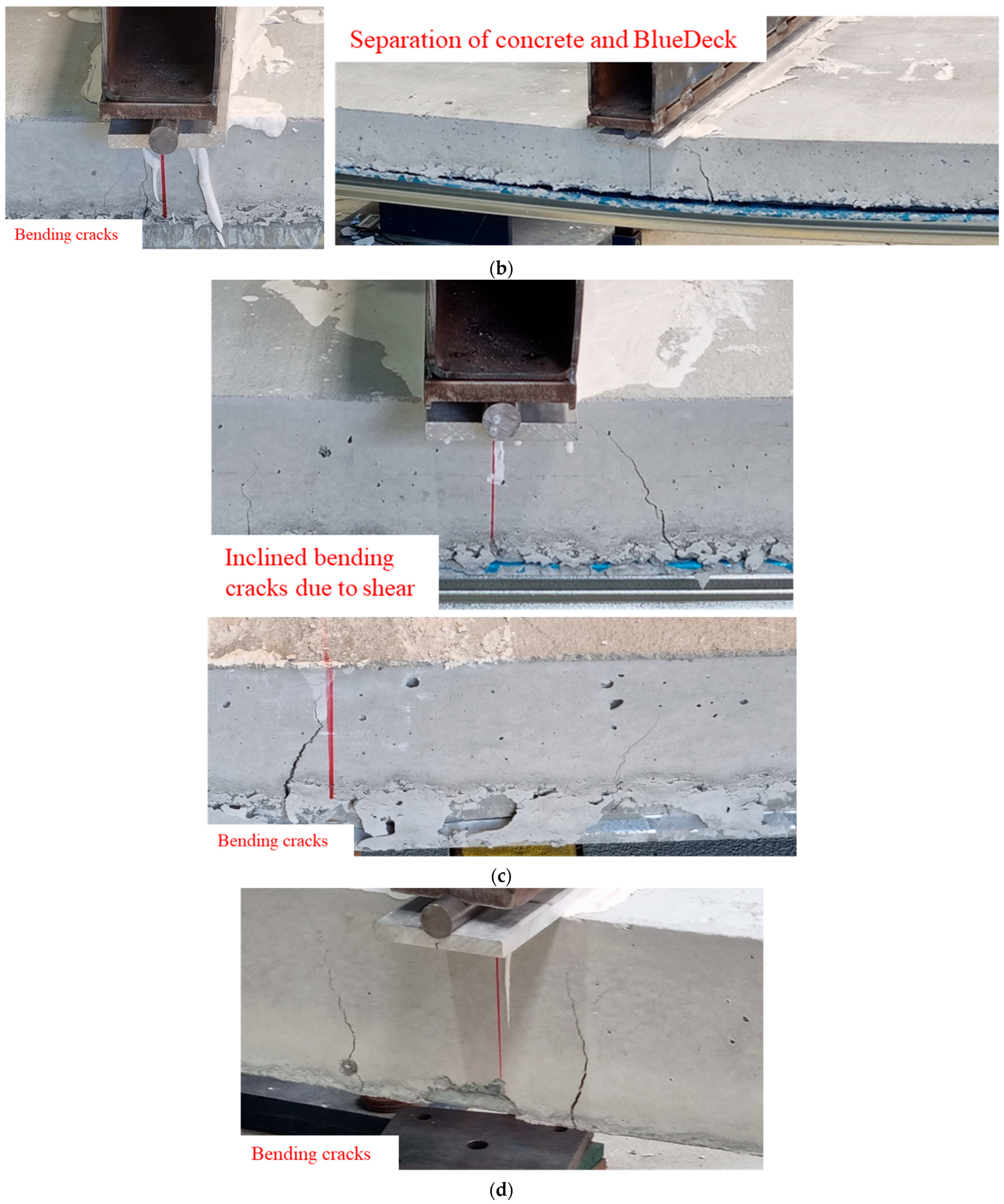
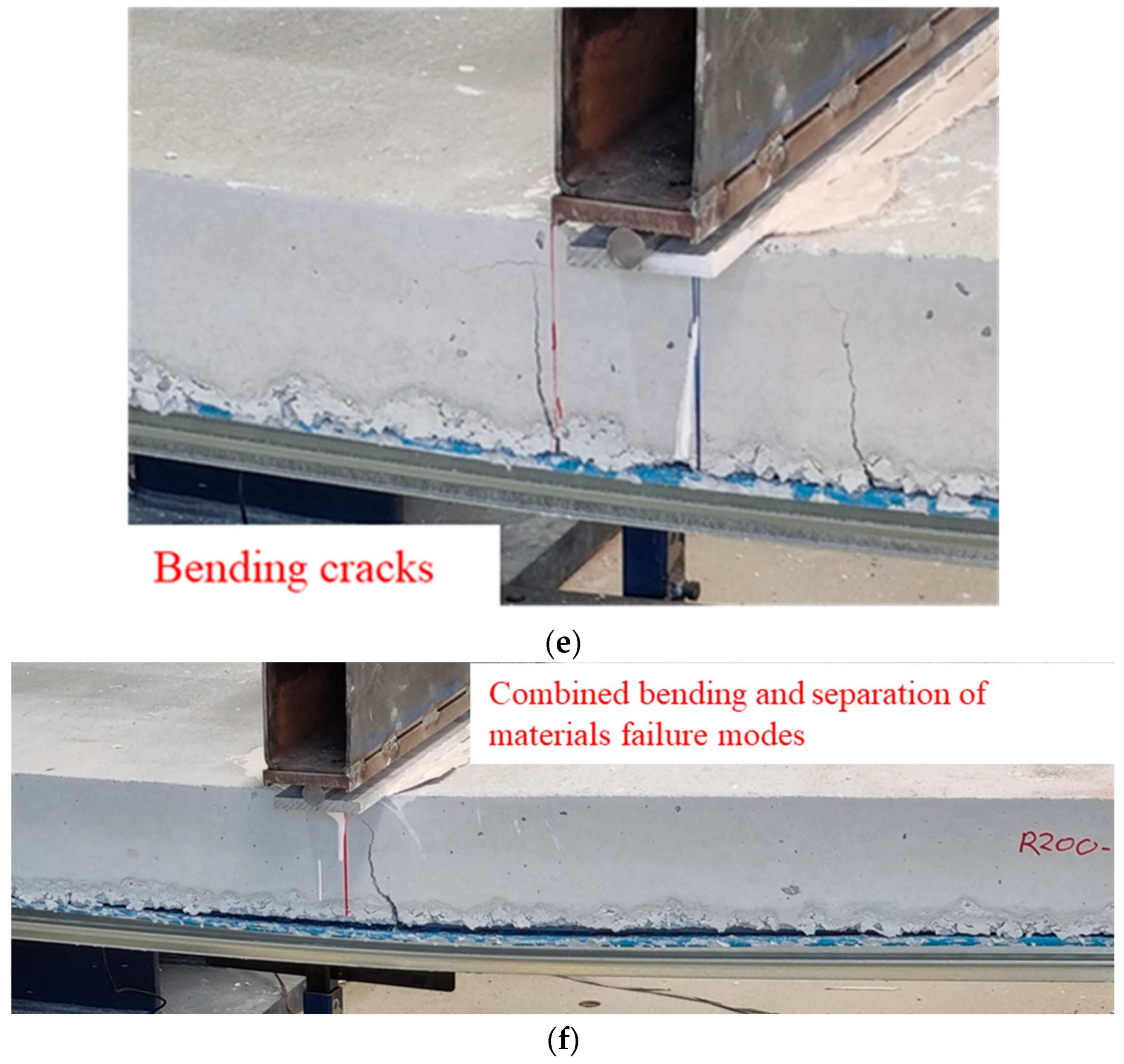

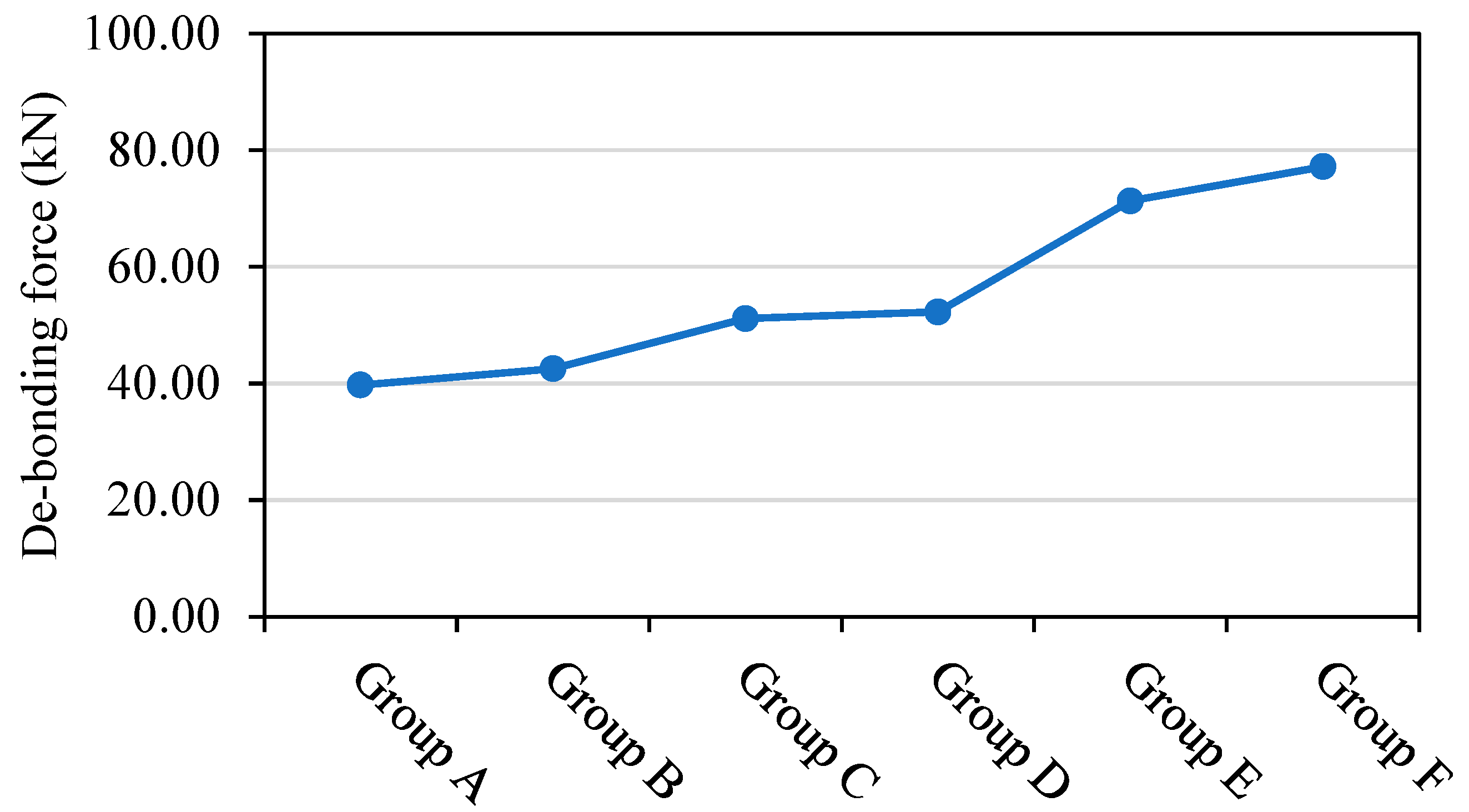
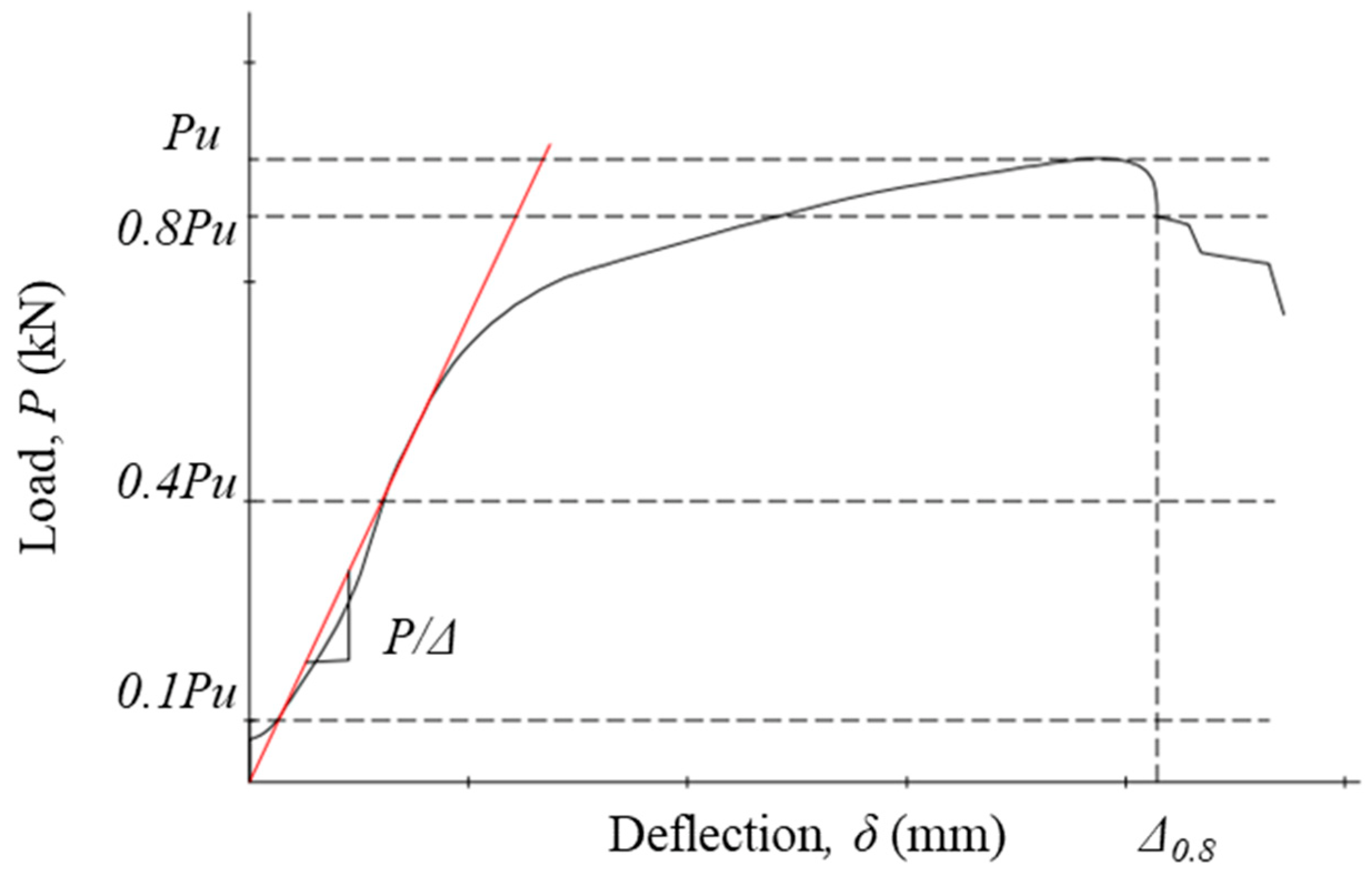

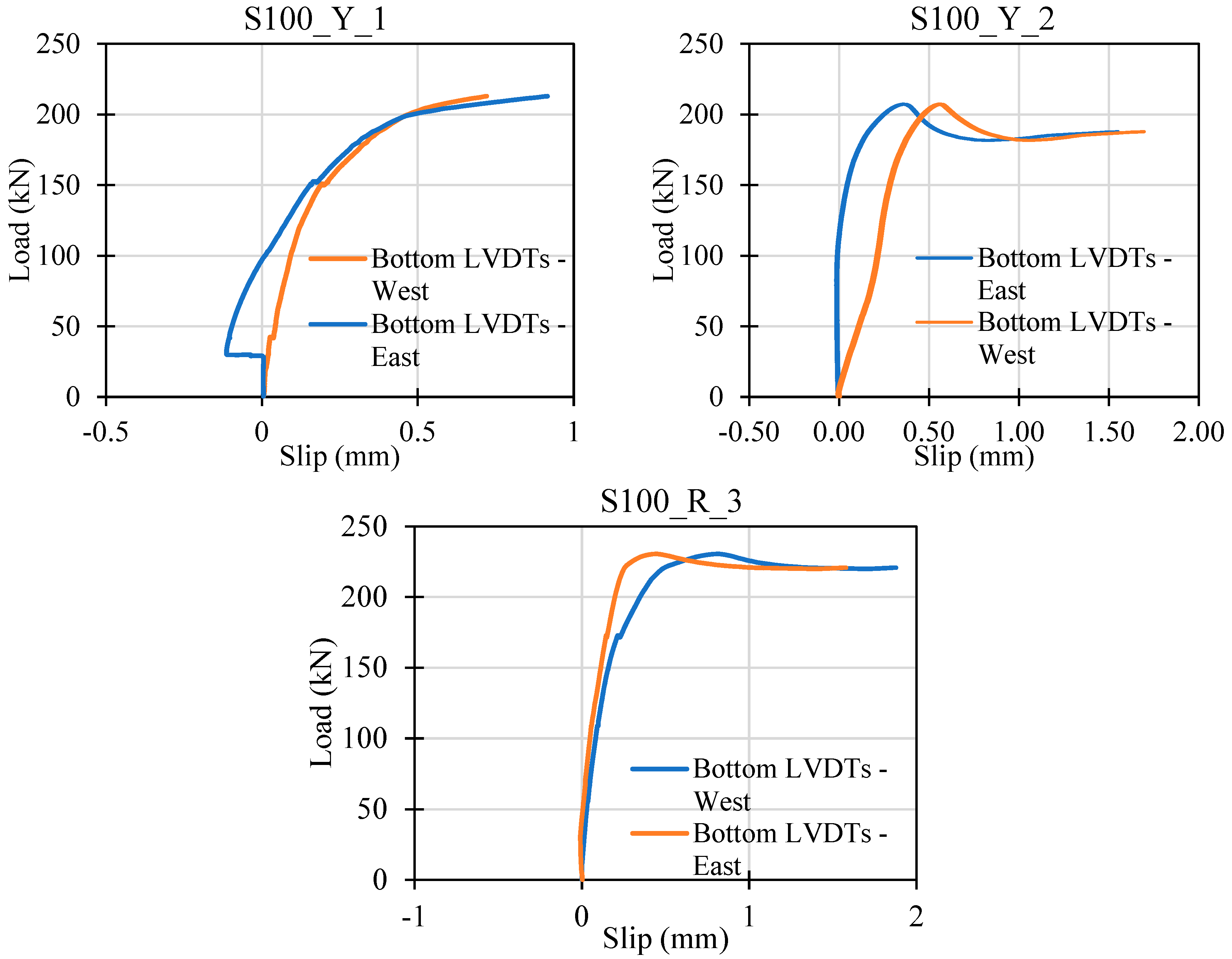
| Thickness (mm) | Mass (kg/m) | Yield Strength (MPa) | Cross-Sectional Area (mm2) | Moment of Inertia (mm4) | Section Modulus (mm3) | Elastic Centroid (mm) |
|---|---|---|---|---|---|---|
| 0.75 | 9.06 | 550 | 1153.86 | 408,220 | 31,353 | 13.02 |
| 1.00 | 11.87 | 550 | 1511.93 | 535,085 | 39,057 | 13.70 |
| Batch No. | Code | Compressive Strength, f′c (MPa) | Density (kN/m3) | Modulus of Elasticity (MPa) |
|---|---|---|---|---|
| 1 | R | 36.80 | 2400 | 30,670 |
| 2 | Y | 39.00 | 2400 | 31,573 |
| Specimen ID | BlueDeck Thickness (mm) | Concrete Depth (mm) | Concrete Compressive Strength (MPa) |
|---|---|---|---|
| Group A samples | |||
| Y150_0-75_1 | 0.75 | 150.00 | 39.00 |
| R150_0-75_2 | 0.75 | 150.00 | 36.80 |
| Y150_0-75_3 | 0.75 | 150.00 | 39.00 |
| Group B samples | |||
| Y150_1-00_1 | 1.00 | 175.00 | 39.00 |
| R150_1-00_2 | 1.00 | 150.00 | 36.80 |
| Y150_1-00_3 | 1.00 | 175.00 | 39.00 |
| Group C samples | |||
| Y175_0-75_1 | 0.75 | 175.00 | 39.00 |
| R175_0-75_2 | 0.75 | 175.00 | 36.80 |
| R175_0-75_3 | 0.75 | 175.00 | 36.80 |
| Group D samples | |||
| Y175_1-00_1 | 1.00 | 175.00 | 39.00 |
| Y175_1-00_2 | 1.00 | 175.00 | 39.00 |
| Y175_1-00_3 | 1.00 | 175.00 | 39.00 |
| Group E samples | |||
| Y200_0-75_1 | 0.75 | 200.00 | 39.00 |
| R200_0-75_2 | 0.75 | 200.00 | 36.80 |
| R200_0-75_3 | 0.75 | 200.00 | 36.80 |
| Group F samples | |||
| R200_1-00_1 | 1.00 | 200.00 | 36.80 |
| R200_1-00_2 | 1.00 | 200.00 | 36.80 |
| R200_1-00_3 | 1.00 | 200.00 | 36.80 |
| Specimen ID | BlueDeck Thickness (mm) | Concrete Depth (mm) | Concrete Compressive Strength (MPa) |
|---|---|---|---|
| Set A | |||
| S75_R_1 | 0.75 | 150.00 | 36.80 |
| S75_Y_2 | 0.75 | 150.00 | 39.00 |
| S75_Y_3 | 0.75 | 150.00 | 39.00 |
| Set B | |||
| S100_R_1 | 1.00 | 150.00 | 36.80 |
| S100_Y_2 | 1.00 | 150.00 | 39.00 |
| S100_Y_3 | 1.00 | 150.00 | 39.00 |
| Specimen ID | Peak Load (kN) | Load at Initial De-Bonding (kN) | Max. Deflection (mm) | Max. Slip–Pin Support (mm) | Max. Slip–Roller Support (mm) |
|---|---|---|---|---|---|
| Group A | |||||
| Y150_0-75_1 | 92.71 | 44.78 | 40.86 | 0.87 | 4.05 |
| R150_0-75_2 | 65.25 | 38.35 | 41.06 | 0.87 | 4.05 |
| Y150_0-75_3 | 76.27 | 36.04 | 56.16 | 1.64 | 4.67 |
| Average | 78.08 | 39.72 | 46.02 | 1.13 | 4.26 |
| Standard dev | 11.28 | 3.70 | 7.17 | 0.37 | 0.29 |
| Group B | |||||
| Y150_1-00_1 | 82.82 | 45.00 | 52.88 | 1.69 | 5.80 |
| R150_1-00_2 | 87.80 | 45.00 | 60.85 | -2.07 | 7.60 |
| Y150_1-00_3 | 83.22 | 37.59 | 61.17 | 2.50 | 1.40 |
| Average | 84.61 | 42.53 | 58.30 | 0.71 | 4.93 |
| Standard dev | 2.26 | 3.49 | 3.83 | 1.99 | 2.60 |
| Group C | |||||
| Y175_0-75_1 | 100.78 | 54.60 | 51.85 | 3.21 | 5.71 |
| R175_0-75_2 | 93.67 | 45.00 | 43.58 | 6.14 | 3.79 |
| R175_0-75_3 | 98.78 | 53.73 | 44.13 | 3.15 | 4.36 |
| Average | 97.75 | 51.11 | 46.52 | 4.17 | 4.62 |
| Standard dev | 3.00 | 4.33 | 3.78 | 1.40 | 0.81 |
| Group D | |||||
| Y175_1-00_1 | 118.15 | 58.03 | 48.65 | 1.48 | 6.39 |
| Y175_1-00_2 | 102.04 | 44.38 | 32.70 | 1.66 | 3.97 |
| Y175_1-00_3 | 105.34 | 54.40 | 55.04 | 1.92 | 9.19 |
| Average | 108.51 | 52.27 | 45.47 | 1.69 | 6.52 |
| Standard dev | 6.95 | 5.77 | 9.39 | 0.18 | 2.13 |
| Group E | |||||
| Y200_0-75_1 | 114.02 | 65.26 | 24.43 | 0.33 | 2.28 |
| R200_0-75_2 | 121.81 | 74.73 | 32.71 | 4.26 | 0.96 |
| R200_0-75_3 | 114.46 | 73.92 | 39.20 | 0.54 | 7.38 |
| Average | 116.76 | 71.30 | 32.12 | 1.71 | 3.54 |
| Standard dev | 3.57 | 4.29 | 6.04 | 1.81 | 2.77 |
| Group F | |||||
| R200_1-00_1 | 124.89 | 88.31 | 29.93 | 1.84 | 3.81 |
| R200_1-00_2 | 144.38 | 69.83 | 37.95 | 2.73 | 4.12 |
| R200_1-00_3 | 162.67 | 73.49 | 55.57 | 3.90 | 9.53 |
| Average | 143.98 | 77.21 | 41.15 | 2.82 | 3.94 |
| Standard dev | 15.42 | 7.99 | 10.71 | 0.84 | 2.62 |
| Specimen ID | Ultimate Shear Strength (kN) | Ultimate Slip (mm) |
|---|---|---|
| Set A | ||
| S75_Y_1 | 188.23 | 1.50 |
| S75_Y_2 | 175.97 | 3.08 |
| S75_R_3 | 181.25 | 4.03 |
| Average | 181.82 | 2.87 |
| Set B | ||
| S100_Y_1 | 213.01 | 0.92 |
| S100_Y_2 | 207.31 | 2.80 |
| S100_R_3 | 216.95 | 1.16 |
| Average | 212.42 | 1.63 |
Disclaimer/Publisher’s Note: The statements, opinions and data contained in all publications are solely those of the individual author(s) and contributor(s) and not of MDPI and/or the editor(s). MDPI and/or the editor(s) disclaim responsibility for any injury to people or property resulting from any ideas, methods, instructions or products referred to in the content. |
© 2024 by the authors. Licensee MDPI, Basel, Switzerland. This article is an open access article distributed under the terms and conditions of the Creative Commons Attribution (CC BY) license (https://creativecommons.org/licenses/by/4.0/).
Share and Cite
Far, H.; Nejadi, S.; Al-Hunaity, S.A. Structural Behaviour and Mechanical Characteristics of BlueDeck Profiled Steel Sheeting for Use in Composite Flooring Systems. Buildings 2024, 14, 3204. https://doi.org/10.3390/buildings14103204
Far H, Nejadi S, Al-Hunaity SA. Structural Behaviour and Mechanical Characteristics of BlueDeck Profiled Steel Sheeting for Use in Composite Flooring Systems. Buildings. 2024; 14(10):3204. https://doi.org/10.3390/buildings14103204
Chicago/Turabian StyleFar, Harry, Shami Nejadi, and Suleiman A. Al-Hunaity. 2024. "Structural Behaviour and Mechanical Characteristics of BlueDeck Profiled Steel Sheeting for Use in Composite Flooring Systems" Buildings 14, no. 10: 3204. https://doi.org/10.3390/buildings14103204








